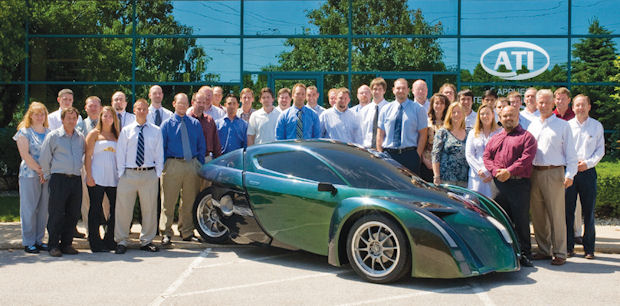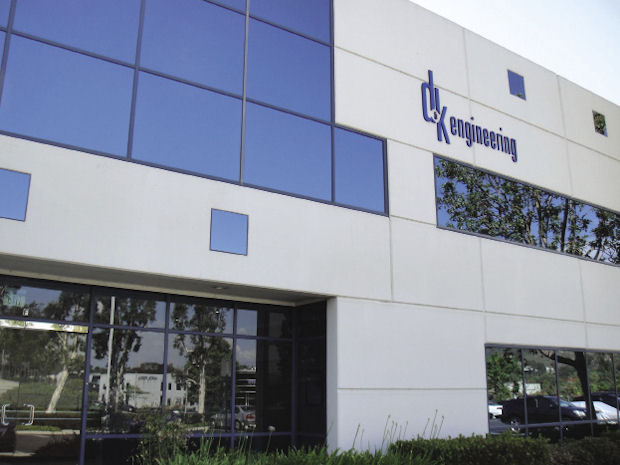
The team at Applied Technology Integration, an Ohio-based engineering services provider.
August 1, 2014
Desktop engineers benefit from external service providers who specialize where the designer is lacking. External providers offer concept development expertise, in-depth analysis and tools, and an array of engineering disciplines to bridge the gaps in resource pools, prevent costly design errors, and keep deliverables on deadline.
Once the decision is made to bring in an outside firm, design engineers should confirm how the external provider plans to insert its services into the designer’s workflow. According to Craig Winn, CEO of Maumee, OH-based Applied Technology Integration (ATI), working with an external provider should be the same as working with internal resources—except that the external resource needs to fit into the workflow in a tighter package.
“This can improve the workflow and the end result, because in order to use an outside resource whom you don’t see every minute of every day, you need to have the program laid out in a detailed fashion, in the Statement of Work,”he adds.
An external provider should identify deliverables and timing more accurately. This can be a difficulty or hindrance for the design engineer who hasn’t previously used an external resource, or who is used to a more casual work environment.
“But it can also be helpful if he needs to get to a certain stage in the project by a certain deadline, because the contractor takes deadlines seriously,”says Winn.
External services should consider communication as integral to the workflow. “We understand what the customer needs, and when, and we let them know what we need, by when, in order to meet the deliverables,”says Winn.
An outsourced provider should also work hand-in-hand with the designer, communicating via phone, online and in-person meetings to clarify the progress of the design. “The relationship should be closely monitored,”says Akbar Farahani, VP of Global Engineering for Troy, MI-based Engineering Technology Associates (ETA).
Protecting Intellectual Property
Design engineers should ensure that the outside vendor safeguards their intellectual property and associated rights. Winn notes there are two basic mechanisms his firm uses to protect intellectual property:
- Intellectual property rights document, or a statement within a document or contract: This states that the customer owns the rights to all intellectual property that it brings to the project or that the supplier develops during the project.
- Two-way non-disclosure agreement (NDA): This states that both parties will conceal any confidential information or intellectual property that they share during a project.
Protecting intellectual property requires certain types of segregation of information, too.
“There is a competitive landscape for our clients that requires that we have ways to firewall different programs within our company,”says Peter Ma, VP of Engineering/R&D for San Diego-based D&K Engineering. Ma notes that some clients don’t want the project team to know their identities. This helps to protect confidentiality rights and intellectual property rights. “Even when we do project prototyping, we set aside a place for that work—and the buildings are locked and secured,”he says.
An external provider should offer options and flexibility in protecting intellectual property rights. “We can protect our clients’intellectual property any way they choose,”says Eric Preissner, President of Ann Arbor, MI-based Preissner Engineering & Consulting, LLC (PEC). He notes that some clients want NDAs; others want patent agreements. The NDA defines any communications about the intellectual property. “We protect Customer A so that Customer B does not see their project,”says Preissner.
The experts agree that design engineers should proactively participate in a living NDA, and that it’s important to review and update the agreement periodically. “We work with companies in the U.S. and in Asia, and pay careful attention to the non-disclosure agreements,”says Farahani. An external provider should also ensure that employees follow International Organization for Standardization (ISO) standards and requirements from the firm’s human resources department as they relate to non-disclosure, so that confidentiality is maintained.
Design engineers should also require contract language that specifies appropriate communications channels for intellectual property data. “When we write proposals and contracts, we set up a process based on customer requirements about how communications and communication channels will be directed so that intellectual property is protected,”says Farahani. Some discussions may be permissible by phone, while others should occur in person.
Advantages of External Provider Relationships
Design engineers should explore the advantages of working with available external firms before making a final selection.
“You can get some unconstrained thinking. The ideas our guys come up with may not meet all the requirements on Day One. We have to tighten them up over time. But we’re more likely to have some fresh ideas because we’re not constrained by all of the controls of the large corporation,”says Winn.
An outside designer can also have more depth in certain areas than the customer or internal designer does. “We tend to have more in-depth design and analysis background than the typical design engineer because that’s all we do,”says Winn.
The additional engineering disciplines that are available with an outside provider are another advantage. “We have all the required disciplines to do whatever our customers want us to do,”says Ma, noting that D&K Engineering works with plastic injection moldings, microfluidics and systems engineering, for example. “We can develop a product very quickly and at a lower cost than an in-house team.”
Then there’s the ability to leverage the detailed and robust analytical tools that the provider has to offer. “Even a mid-sized customer does not have these tools,”Preissner points out. Whether it’s computational fluid dynamics (CFD) or high-end finite element analysis (FEA) tools, they require a certain level of experience and buy-in financially to keep and maintain. A company that does manufacturing may need them at the beginning of a project, but not throughout. With an outside provider, a designer does not have to pay for a service when they don’t need it.
Other advantages can include being faster, more efficient, and more cost-effective than in-house processes. “We enable a designer to move to a variable cost that is controlled during the different project phases,”says Farahani, noting that this can reduce overall project costs.
Desirable Early-stage Concept Developments
Design engineers should ensure as large an intersection as possible between the early-stage developments they need and the ones an available firm can best offer. These can include packaging ideas and concepts, and turning a product into a device that manufacturing can produce.
“In almost any industry, this includes weight reduction concepts and mass production concepts,”Winn says. “And then there are fuel economy concepts with almost any entity that has things that move, such as airplanes, trucks, cars and trains.”
Other early-stage design concept developments customers accept include materials designs, and the use of new technologies like additive manufacturing (AM). “These are the concepts we put in front of customers quite often,”says Winn.
“We work on early-stage requirements such as problem solving and establishing requirements. That takes a lot of collaboration, white boarding sessions, and talking through design needs,”says Ma.
An examination of the design space is especially helpful early on, Preissner points out. “We can evaluate different choices in the design space more rapidly than a design firm can put a detailed model together,”he says, noting that an external provider can look at potential solutions at the top level, and eliminate things that are not fruitful to pursue. “We can help them to more rapidly focus on viable designs.”
More Info
Subscribe to our FREE magazine, FREE email newsletters or both!
About the Author
David Geer is a freelance technology writer based in Northeast Ohio.
Follow DE







